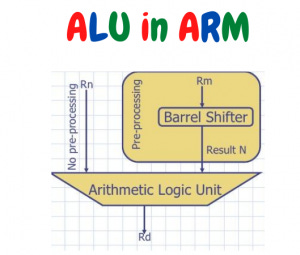Understanding the Arithmetic Logic Unit (ALU) in ARM Processors
A Closer Look at ARM’s Computational Powerhouse
The Arithmetic Logic Unit (ALU) is the foundation of any microprocessor, including ARM processors. It is responsible for performing arithmetic and logical operations, which are essential for the execution of instructions in a computing system. In this blog post, we will understand the role of the ALU in ARM processors, its components, and how it integrates with other parts of the CPU to facilitate efficient data processing.
The Role of the ALU
The primary function of the ALU is to decode and execute arithmetic and logical operations based on electronic code instructions. When a processor receives an instruction, the ALU interprets the operation to be performed and executes it on the data provided. This data typically comes from the system bus and the accumulator, a special register that stores intermediate results.
In ARM processors, the ALU handles a variety of operations, including addition, subtraction, AND, OR, XOR, and bit-shifting. These operations are fundamental to the execution of both simple and complex instructions, making the ALU a critical component for the overall performance of the processor.
Components of the ALU
The ALU in ARM processors is composed of several key components that work together to perform its functions:
Accumulator: The accumulator is a register that stores the results of arithmetic and logical operations. It plays a crucial role in ensuring that intermediate results are readily available for subsequent operations. The accumulator's size is adjusted based on the length of the system bus, ensuring compatibility and efficient data transfer.
Barrel Shifter: ARM processors often include a barrel shifter within the ALU. This component is used for bit-shifting and rotating data, which are common operations in many algorithms. The barrel shifter enhances the ALU's capability by allowing it to perform these operations in a single clock cycle, improving overall efficiency.
Control Signals: The ALU is controlled by several signals that dictate its operation. In ARM processors, there are typically three additional control signals that can be decoded to manage the ALU's specific components. These signals ensure that the ALU performs the correct operation based on the instruction being executed.
Zero Flag: The ALU includes a single-bit outcome known as the zero flag. This flag goes high (1) when all the bits in the accumulator are zero, indicating that the result of the last operation was zero. The zero flag is essential for conditional branching and decision-making in program execution.
Integration with the Processor
The ALU in ARM processors is tightly integrated with other components of the CPU to ensure seamless data processing. It shares the same clock and reconfiguration transmissions as the Program Counter (PC), which keeps track of the next instruction to be executed. This synchronization ensures that the ALU operates in harmony with the rest of the processor.
The ALU's bus interface is characterized as an input and output logic module bus. This interface allows the ALU to receive data from the system bus and send the results of its operations back to the bus for further processing or storage. The integration of the ALU with the bus system is crucial for maintaining the flow of data within the processor.
Performance and Efficiency
The design of the ALU in ARM processors emphasizes performance and efficiency. By incorporating components like the barrel shifter and optimizing the control signals, ARM processors can execute complex instructions quickly and with minimal power consumption. This efficiency is one of the reasons why ARM processors are widely used in mobile devices, embedded systems, and other applications where power and performance are critical.
Conclusion
The Arithmetic Logic Unit is a vital component of ARM processors, responsible for executing the core arithmetic and logical operations that drive computing tasks. Its integration with other processor components, such as the accumulator and barrel shifter, ensures efficient and synchronized data processing. Understanding the role and structure of the ALU provides valuable insights into the inner workings of ARM processors and their ability to deliver high performance in a wide range of applications.
As technology continues to evolve, the ALU will remain a fundamental element of microprocessor design, adapting to new challenges and enabling more advanced computing capabilities. Whether you're a student, engineer, or tech enthusiast, appreciating the intricacies of the ALU can deepen your understanding of modern computing systems.


